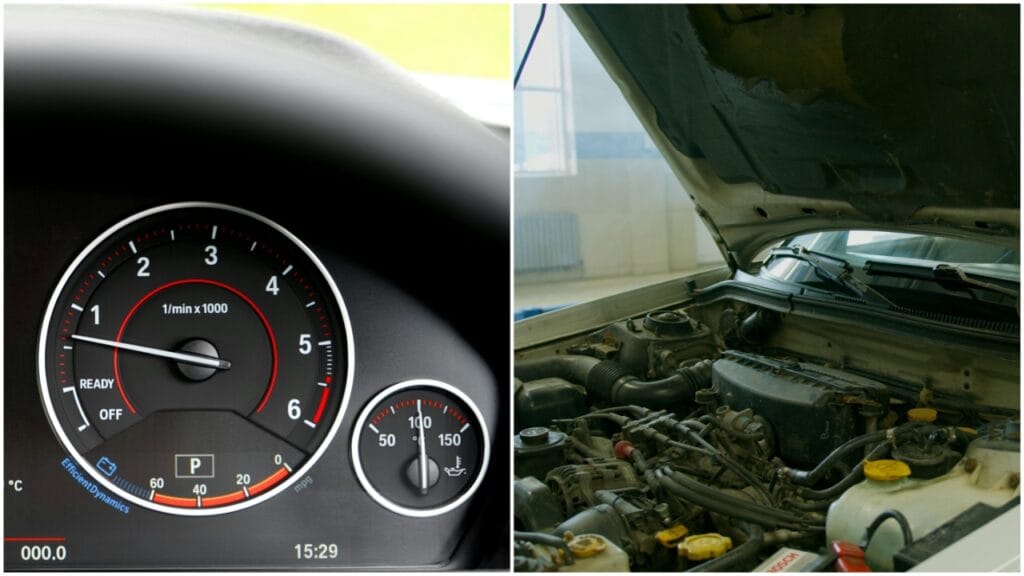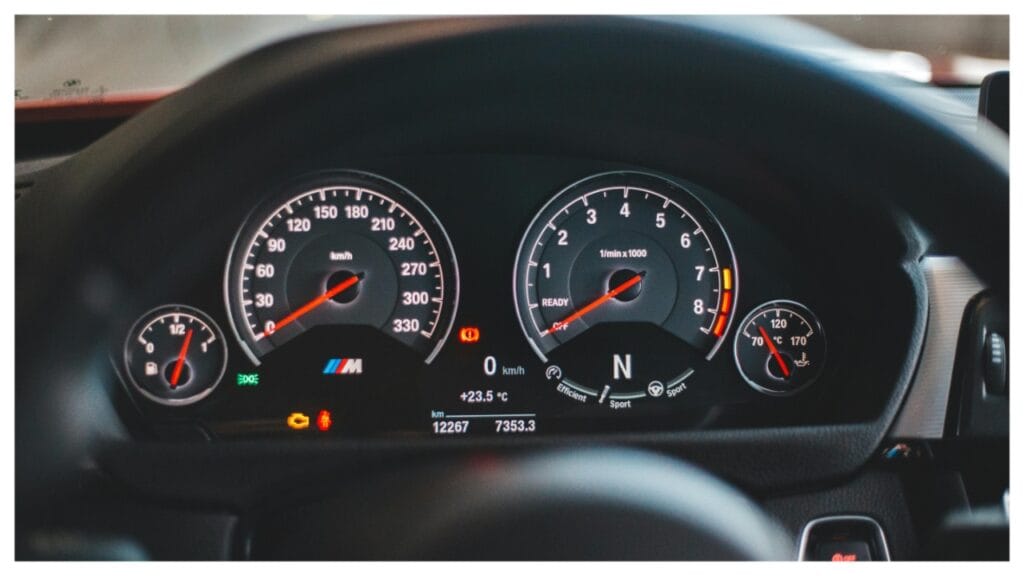Concerning coolant temperature, anything above 240°F (115°C) can be considered too high for most vehicles, signaling potential engine overheating. Ideally, you want the coolant to stay between 180°F and 220°F (82°C to 104°C). This range allows the engine to run efficiently and avoids risking damage.
Exceeding that safe range can lead to severe problems. These include head gasket failure, warped engine components, or a complete breakdown. Suppose your dashboard temperature gauge starts creeping towards the red zone.
In that case, it’s essential to tackle it quickly. You can pull over to let the engine cool. Check for issues like low coolant levels or a malfunctioning thermostat. Keeping the temperature in check ensures your engine stays healthy and running smoothly. Let’s know more details below:
The Engine’s Love-Hate Relationship with Heat

Engines thrive in a particular comfort zone, but if you push them too far, they get cranky. When engines overheat, they don’t just grumble or refuse to cooperate—they melt, warp, or seize up.
Now, your engine needs heat to work. After all, it’s a combustion machine burning fuel to create power. But here’s the kicker: too much of it, and things go haywire. Too little, and it won’t run efficiently. So, where’s the Goldilocks zone?
In the ideal world, you want your engine’s coolant temperature to sit around 195 to 220 degrees Fahrenheit. That’s where things run smoothly. But what happens when you edge toward 230 or even 250 degrees? Is that the breaking point, or is there some wiggle room? Let’s unravel this.
What Happens When the Temp Rises?
Engines get hot because they’re doing a lot of work: friction, fuel burning, and metal components rubbing against each other at thousands of RPMs. The coolant (a mix of water and antifreeze) removes the excess heat.
But things aren’t quite peachy when your coolant temperature starts hitting that 230-240°F range. Metal components begin to expand, gaskets soften, and the oil gets thinner—way thinner. Think of oil as your engine’s blood. If it gets too thin, it won’t lubricate well, and that’s where damage happens.
If you let things roll past 250°F, you’re in serious trouble. At this point, the coolant will boil over. You will see steam shooting out from under the hood at that moment. If you’ve ever wondered why boiling coolant is so bad, remember this: once it boils, it can’t circulate properly.
Why High Temps Are Dangerous: The Domino Effect

High temperatures don’t happen in isolation. When the engine overheats, you’re looking at a domino effect of disasters waiting to happen. First, there’s the possibility of damaging the head gasket. That’s like your engine’s bouncer, keeping oil and coolant separate. A blown head gasket?
Then, you’ve got the potential for warped cylinder heads. This can lead to misfires, loss of compression, and overall poor engine performance. Imagine baking a cake in an oven set to 350 degrees that suddenly jumps to 500 degrees. It’s not going to end well.
And the longer your engine stays hot, the more these little issues stack up. Seals start to break down. Piston rings do not seal properly. Suddenly, you face an engine on the fast track to failure.
What’s “Too High” Anyway?
So, when does hot become too hot? It’s easy to say that any temperature above the normal operating range is dangerous. Nevertheless, the situation is more nuanced. For most engines, anything consistently over 220°F is a red flag.
But, and this is a big “but,” some engines are built to handle slightly higher temperatures. High-performance or turbocharged engines often run hotter than their average commuter-car counterparts.
These refined engines can run up to 240°F for short bursts, which is significant if they have upgraded cooling systems.
The Importance of the Right Coolant Mix

Not all coolants are created equal. A suitable coolant mix is typically a 50/50 blend of water and antifreeze (ethylene glycol). Water alone would boil too quickly, especially at higher altitudes, and pure antifreeze needs to be more efficient to cool the engine.
Together, they form a perfect partnership, lowering the freezing and boiling points. Now, it gets tricky. If you use the wrong coolant mix, your engine’s temperature skyrockets even under normal conditions.
If you have more water than antifreeze, your coolant will boil faster. This is especially true on a scorching summer day. Too much antifreeze and your engine does not cool down fast enough, leading to—you guessed it—overheating.
It’s always a good idea to check your coolant levels and ensure you have the correct ratio. And is your engine running hot despite everything being in place? Well, it is time to flush the setup or check for clogs in the radiator.
What to Do When Your Engine Overheats
First, don’t panic. Panicking leads to poor decisions. For example, shutting the car off instantly traps heat in the engine, causing more damage. Instead, pull over safely and let the engine idle.
Turning off the AC helps relieve some of the load on the engine. Cranking up the heater can pull heat away from the engine, giving your radiator much-needed breathing room.
You can carefully check your coolant levels once you’ve stopped and the engine has cooled down. But—and this is crucial—don’t open the radiator cap while the engine is still hot.
If your coolant level is low, adding more gets you to a service station. But if you see any leaks or the temperature keeps rising, it’s time to call in the professionals. Continuing to drive with an overheating engine is like walking on thin ice: sooner or later, something will crack.
What’s a Good Temperature?

You’re golden if your engine temperature stays between 195 and 220 degrees Fahrenheit. That’s the range where everything operates smoothly—your oil remains at the proper viscosity, and your metal components don’t expand too much.
Some engines can handle brief moments of heat in the 230-240°F range, but that’s the edge of the danger zone. Consistent temperatures above that? It’s time to check your cooling system, replace your thermostat, or see if that radiator fan is doing its job.
Wrapping It Up
Keeping your engine at the right temperature is all about balance. Coolant, airflow, and oil viscosity all guarantee your engine runs smoothly without overheating.
The next time you see that temperature gauge inching higher, remember: your engine is like a finely tuned athlete. Push it too hard, and it’ll overheat. Keep it cool, and it’ll run like a champion.
FAQ’s
Engine coolant temp high?
Oh man, I’ve been there! Seeing that engine coolant temp warning is never a good feeling. It means the engine is getting way too hot, and that’s bad news. One time, I ignored it for a few minutes, and let’s just say—I regretted it big time. Could be low coolant, a bad thermostat, or maybe the radiator is acting up.
I always check my coolant level first. But here’s the thing—you gotta wait for the engine to cool down before opening anything. Trust me, hot coolant spraying everywhere is not fun. If topping it off doesn’t fix it, there’s probably a bigger issue, like a leak or a busted water pump. I learned the hard way that driving like this can wreck the engine.
Blown gasket? Yeah, not cheap to fix. If I ever see steam, I shut it down immediately. No risks! Now, I make sure to check my coolant regularly and flush the radiator when needed. A little maintenance saves a whole lot of trouble. So if that temp gauge is climbing, don’t wait—pull over, check it out, and take care of it before it turns into a real disaster!
Car coolant temperature high:
When your car’s coolant temperature rises, act quickly to avoid damage. Start by pulling over safely and turning off the engine.
Let it cool before opening the hood. Never open the radiator cap when the engine is hot. Steam can cause burns.
Check the coolant level in the reservoir. Low coolant is a common cause. If it’s below the minimum line, add more. Use the type recommended for your car.
Look at the radiator fan. It could be a bad motor or a blown fuse if it’s not spinning. Check the drive belt, too. A broken or loose belt can stop the water pump from circulating coolant.
If the coolant is full and there’s no apparent issue, it might be a stuck thermostat. This prevents coolant from flowing properly, so getting a mechanic’s help is best.
Keep your car off until the issue is resolved. Driving at a high coolant temperature risks engine damage.
What engine temp is too high?
An engine running too hot can cause severe damage. Most engines should operate between 195°F and 220°F. If your engine reaches temperatures higher than this, it’s a sign something might be wrong.
A temperature above 240°F is especially concerning. At this point, the engine can overheat. Overheating is bad news for any vehicle. It can lead to warped parts or a blown head gasket, which is costly.
The causes of high engine temperatures can vary. A low coolant level is a common culprit. A broken thermostat or radiator fan can also cause problems. If the water pump malfunctions, it won’t circulate coolant properly, causing the engine to get too hot.
If your engine starts to overheat, pull over safely, turn off the engine, and let it cool down. If possible, check coolant levels.
High coolant temperature!
High coolant temperature is a warning sign that your engine is overheating. Several factors, such as low coolant levels, a broken thermostat, a damaged radiator, or a failing water pump, can cause this.
If the coolant level is low, it won’t be able to absorb and dissipate heat properly. A malfunctioning thermostat may not open correctly, causing the engine to overheat.
A damaged radiator can restrict the coolant flow, while a failing water pump will prevent coolant from circulating.
When the engine temperature rises too high, it’s not just a warning sign-it’s a potential disaster. Overheating can warp engine components, blow gaskets, or even cause the engine to seize.
It’s crucial to allow the engine to cool down before checking the coolant levels. And remember, never open the radiator cap while the engine is hot, as it can cause burns or further damage.
To avoid high coolant temperatures, perform regular maintenance, such as checking coolant levels and inspecting the radiator and hoses for leaks.
The coolant temperature is low!
A low coolant temperature can mean your engine isn’t reaching its optimal operating range, affecting performance and reducing fuel efficiency.
Your engine thrives in a sweet spot, usually around 195-220°F. At this temperature, it can burn fuel efficiently. The oil also maintains the proper viscosity to protect all those moving parts.
If the coolant is too cold, it indicates a thermostat stuck open. The engine cannot warm up properly, and the coolant circulates too much.
Over time, this can lead to problems like increased wear and tear on the engine or poor fuel economy. It doesn’t sound as dramatic as overheating. Yet, running your engine too cold for too long can cause long-term issues.
Engine won’t reach operating temp:
When your engine doesn’t reach its operating temperature, something is wrong with your cooling system. Most often, a thermostat is stuck open.
The thermostat controls coolant flow through the engine, only letting it circulate once it warms up. If it’s stuck open, coolant will flow constantly, never giving the engine a chance to heat up properly.
This seems like a minor issue, but an engine that doesn’t reach its ideal operating temperature—typically around 195-220°F—will not run efficiently.
Cold engines burn more fuel because the air-fuel mixture stays richer. The oil doesn’t thin out enough to lubricate internal components effectively. This can lead to increased wear over time.
You notice a dip in fuel economy and sluggish performance in the short term. The cabin’s heater produces poor heat because the engine isn’t producing enough heat to warm the air.
Running an engine consistently below its proper temperature can cause long-term damage. This includes carbon buildup inside the engine because combustion doesn’t happen as cleanly.
If your engine isn’t warming up, check the thermostat. Alternatively, please bring it to a mechanic to get it sorted out. Fix it before those minor problems snowball into bigger ones.
Temperature gauge not working and fan running:
Your temperature gauge isn’t working, the cooling fan is constantly running, and there is a problem with your car’s engine control system. These issues are often related to the coolant temperature sensor (CTS).
The CTS provides crucial data to the temperature gauge and the engine control module (ECM), which regulates when the fan turns on and off.
When the sensor fails or sends incorrect information, the ECM thinks the engine is overheating. Even if it’s not overheating, the fan runs nonstop as a precautionary measure.
This also explains why the gauge is not working—it is not receiving the proper signal from the faulty sensor.
In some cases, a wiring issue is at fault. A blown fuse is the culprit as well. This interference affects the sensor’s ability to communicate with the gauge and the fan. It’s also possible the fan relay is stuck in the “on” position due to an electrical fault.
This will not instantly harm your engine, but it’s something to handle. Fix it before it causes unnecessary wear on your fan or leads to other complications.
A mechanic can quickly diagnose this issue by checking the sensor, wiring, and relays and replacing faulty components.
conclusion
A malfunctioning temperature gauge and a constantly running fan show a problem. This issue often relates to the coolant temperature sensor or an electrical issue.
Your engine is not in immediate danger. Still, ignoring it leads to more significant issues, like unnecessary fan wear and potential overheating that goes unnoticed.
It’s best to get it checked out by a mechanic sooner rather than later. A simple fix like replacing a sensor can restore everything to normal. Repairing a wire also helps keep your engine safe. This ensures your cooling system works as it should

